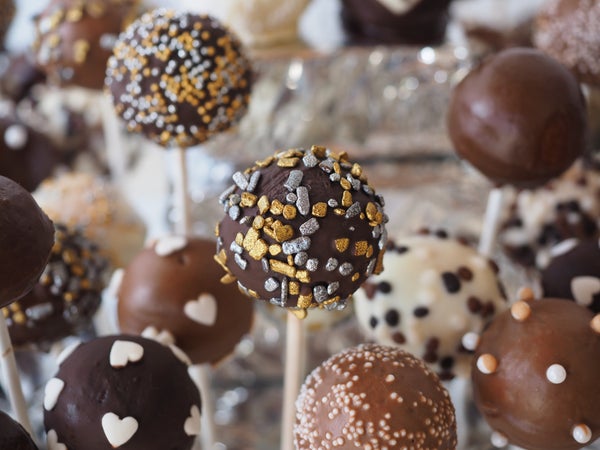This article was published in Scientific American’s former blog network and reflects the views of the author, not necessarily those of Scientific American
On supporting science journalism
If you're enjoying this article, consider supporting our award-winning journalism by subscribing. By purchasing a subscription you are helping to ensure the future of impactful stories about the discoveries and ideas shaping our world today.
The American celebration of Halloween means scary stories, costumes, horror movies—and chocolate. For children the delicious anticipation of bite-sized morsels of favorite candy bars delivered as treats into waiting buckets is a highlight of the night. And for adults, eating the leftovers (or sampling the intended stash) is a perk. Halloween is the biggest candy-selling holiday In the United States. Americans spend an average of $2 billion on Halloween candy. And the chocolate industry itself is relatively robust: revenue for 2018 is projected at $26,476 million—with a predicted growth of 3% annually per year thru 2021. Clearly we like chocolate. And new evidence suggests we’ve been growing and using the cacao plant for over 5,000 years.
While much of the world’s chocolate today is grown in West Africa, the cacao tree is native to the upper Amazon tributaries. However until recently much of the evidence concerning its use came from pre-Columbian Mesoamerican societies. Seeds from Theobroma cacao were dried, ground, and made into a variety of drinks that included additional spices and flavors suited to the events. These drinks played a significant role in rituals, feasts, and consumption by the elite, as evidenced by the varied and elaborate containers that were created for preparation, storage, and serving. The seeds were a key commodity for trade and were used as tribute payment and as currency. And the cacao trees, their pods and seeds, and the resulting drinks were also featured prominently in their mythology.
Unfortunately, the humidity of the Amazon doesn’t create an environment conducive to the preservation of botanical samples. The history of the domestication of the cacao plant is tied to the above ethnohistoric understanding drawn from cultural artifacts. Researchers hypothesized that given the prominence of chocolate in pre-Columbia Mesoamerica, the plant must have been domesticated and spread throughout Central America and Mexico. Archaeological evidence for the pre-Columbia use of cacao dates to approximately 3,900 calibrated years BP. However, physical remnants of plant tissues and ancient DNA recovered from the Santa Ana-la Florida (SALF) site in southern Ecuador challenges this theory. Radiocarbon dating of evidence from this site pushes the earliest use of cacao to 5,430-5300 calibrated years BP—and moves potential domestication more firmly into the Amazon.
The researchers retrieved starch grains from the charred cooking remains still attached to recovered ceramic sherds, as well as residues from ceramic bottles and stone artifacts. Starch grains are used by plants to collect energy; they are complex carbohydrates and not living cells. They compared these remnants to modern seeds starches from the cacao plant (genus Theobroma) and its wild relative (genus Herrania). The starch grains matched those found in modern Theobroma, which allowed allowed researchers to confirm the samples belonged to the Theobroma genus.
With the genus established, the researchers went in search of ancient DNA. They believed the porous nature of the artifacts they recovered could have retained chemical residues—specifically theobromine—from the plants. They scraped the interior of the vessels and sherds to test whether the pottery had absorbed theobromine from the contact with Theobroma. Twenty-eight percent of the samples tested positive for theobromine. Finally, ancient DNA was extracted from the residues collected from the ceramic samples. Upon analysis, results demonstrated sequences specific to Theobroma cacao.
This evidence supports the revised date and place for early use and domestication of cacao. Ethnographic work tells us that that many present-day Indigenous cultures in Ecuador still prioritize cacao and chocolate products. Domesticated cacao and seeds from wild relatives are consumed; leaves and bar are used for medicinal purposes; and the pulp is eaten as a snack. Part of the reason the story of chocolate has unfolded as it has is due to the nature and experience of European contact. In Mesoamerica cacao’s prominence was notable at the time of their arrival. It is possible that its significance had simply begun to wane in South American cultures by that point.
Chocolate retains some of the perceived value originally assigned by Indigenous people: Companies can charge a premium for higher quality products and for assortments to fill Halloween bowls—and there is an unofficial hierarchy to the resulting snacks, which any trick-or-treater can relay as they assess their haul. It isn’t surprising then that chocolate remains a key commodity in this modern version of a trade relationship.
Comments are disabled here. But you are welcome to join the AIP community on Facebook.
—
Referenced:
Zarillo et. al. (2018) "The use and domestication of Theobroma cacao during the mid-Holocene in the upper Amazon.” Nature Ecology & Evolution: https://www.nature.com/articles/s41559-018-0697-x
—
You might also like:
